The 'Cin�matographe Lumi�re' a myth? (original) (raw)
<font="+2" color="#FF2400">Who invented the cinema?</font="+2">
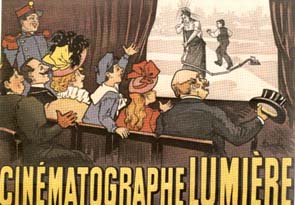 |
|---|
The 'Cin�matographe Lumi�re'
The genesis of cinematography distinguishes two dates:
in 1888 the technology became available and from 1900 onwards film language developed.
By: Tjitte de Vries
Louis (left) and Auguste Lumi�re
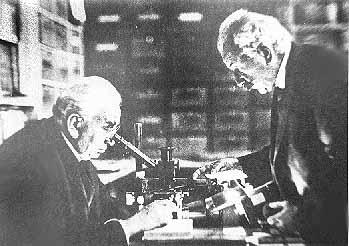 |
|---|
Usually the first public filmshow by the brothers Auguste and Louis Lumi�re on 28 December 1895 in the Grand Caf� on the Boulevard des Capucines in Paris is considered the date of birth of the cinema.
The first program consisted of short one minute subjects taken by Louis Lumi�re credited as inventor as well as cameraman.
A short scrutinage of existing literature raises a number of questions about the veracity of this common conception.
We are confronted with two real problems. How to find out what really happened in 1895? How reliable are the historians of established reputation? The history of the cinema was mainly recorded by reporters and historians who were principally concerned in the final product of this venture: the actual films, the actors, directors and producers. The history of the development of technology, photochemics and industry escaped their attention. Therefore to them there was no compelling reason to raise doubts about the Lumi�re myth.
Program of the first Lumi�re film shows in Londen.
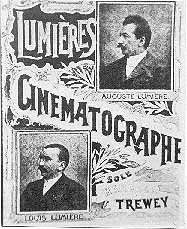 |
|---|
But they were the very film reporters and historians who recorded what happened more than a hundred years ago including the technological inventions and the rise of the industry. Deceiving as the Lumi�re myth is, it conceals that before the 28th of December 1895 there had already been dozens of public film shows.
Strange experiments
Should the Kinetoscopes of Edison, seen in parlours all over the world, be left aside? And the 'Marvelous Cinematograph' of Jean Acm� Leroy? As early as February 1895 this technical co-worker of Louis Aim� Augustin Le Prince gave movie shows for a paying public in Clinton, New Jersey. In august 1895 the British inventor Birt Acres gave public film performances in Barnet, North of (now in) London. From 1st November 1895 Max Skandanowski demonstrated with his brother 'Das Bioskop' films in Berlin. Acres' assistant Arthur Melbourne-Cooper gave his first show for a paying audience on 18th December 1895 in North Mymms in Hertfordshire, Great Britain. Just to name a few !
Film historians have sought to solve this problem by posing that the genesis of cinematography has been a gradual development. Isn't this a pseudo solution?
Such theory does not take account of the fact that all over the world a frantic search was going on to make the photographic image move. From photographic technical publications it was clear what the object of the investigation was and everyone knew what the other was doing in this direction.
Augustin Le Prince in the garden of the house of his in-laws in Leeds around 1900.
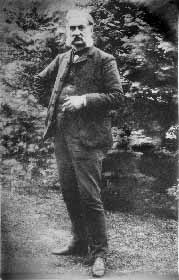 |
|---|
As early as 1888 Augustin Le Prince (1842 - 1900?) was able to take motion pictures and project them. In the studios of Edison movies were already being produced in 1892.
Prince's camera is now on exhibit in the Science Museum, London.
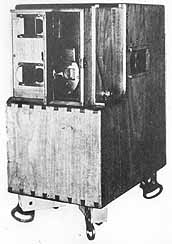 |
|---|
For years Edison claimed to be the inventor of the cinema. His contribution was demythologized in a number of studies of American film historian Gordon Hendricks. From 1892 Birt Acres (1854-1918) was working on an ever better version of his 'kinetic camera', resulting in the 'Kineopticon'.
In 1892 the young engineer L�on Bouly designed a successful 'Cin�matographe'. In 1893 he was granted a patent on an improved version, the 'Cin�matographe Bouly'. The apparatus still exists and is on exhibit in le Mus�e des Arts et M�tiers, Paris.
Alas, Bouly couldn't come up with the yearly patent fees. Antoine Lumi�re, proprietor of an international enterprise in photographic materials, had his works manager, Carpentier, take Edison's kinetoscope apart. He now picked up the expired patent and obtained one on the Cin�matographe Lumi�re in the name of his sons Auguste and Louis.
Lumi�re even borrowed the name 'cin�matographe'. Little mercy in business! The French reporter L�o Sauvage, who was for years manager of the foreign department of the French daily Le Figaro in New York, wrote a grim book L'affaire Lumi�re, in which he unravels one of the biggest publicity stunts in film history.
However, Lumi�re came just at the right moment. The interest of the public had been aroused. That public could now be reached large-scale. So a basis was established for the financial-economical development of a new business enterprise.
The second problem is referred to by British film historian Rachael Low, who writes in the second part of her 'The history of the British Film" : (....) many strange and unsuccessful experiments were tried. Such an instance is the firm in 1908 which advertised itself as 'producers for the wholesale trade only', with equipment and staff of its own to make films to order.'
This shows that the author has little insight in the economic prerequisites for the development of a new branch of industry. Its success hinges on the first product life cycle (a cyclical period of 6 to 8 years) : specialization in production, distribution and marketing. The same happened in photography half a century before and for that matter in the computer industry in recent times .
The firm Rachael Low wrote about was Alpha Trading Company in St. Albans of the aforemonetioned Arthur Melbourne-Cooper (1874 - 1961). After leaving Acres he produced hundreds of films per year and exported them to all parts of the world. Amongst them were forerunners of the Keystone Cop comedies and very early puppet animation films. In that same period the big studios emerged such as Path�, Gaumont, Biograph and Edison.
Two dates
To classify said problems I should like to split the birth of the cinema in two parts. First of all the technical-economical history and secondly the history of the 'motion picture' as the final product.
We can determine the moment of birth of the technology of cinematography with great certainty. It was the year 1888. What was being recorded and projected had more resemblance to the domain of photography or Victorian optical toys such as zoetropes and praxinoscopes than to the cinema.
As from 1900 we can focus on the history of the final product: the movies.
By making this distinction we may also determine whether it was indeed a matter of a haphazard development. Or can we detect certain fixed patterns? Did earth emerge out of chaos and coincidence, or was it created in seven days?
Marey, Le Prince, Reynaud
Mus�e Gr�vin, Paris, where Emile Reynaud held his well-attended shows with his Th�atre Optique
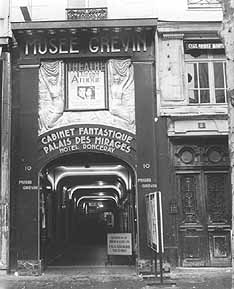 |
|---|
Why did the year 1888 stand out?
Three events happened as a result of which the basis technology of the present cinematography was laid down in patents.
- In 1888 professor of physiology �tienne-Jules Marey of the Académie de Médicines at Parc des Princes demonstrated his 'Chronophotographe', an apparatus which he needed to record movements for his research into heart and blood circulation.
- In the same year Parisian �mile Reynaud was granted a patent for the use of perforations on visual strips with drawn animated pictures, which were shown with great success in Musée Grévin, Paris.
- 1888 is also the year that Le Prince made his first successful experiments and went in pursuit after further finance capital to develop his invention, for he was eager to come first with a cinematographic diorama. He did not succeed. To save his family from the disgrace of bankruptcy he disappeared without trace in France. Probably he enlisted in the Foreign Legion.
Le Prince's in-laws Whitley and son Adolphe Le Prince made their appearance in the garden of their house in Leeds in 1888. This may be considered the first successfully photographed and projected motion picture in the world. The images were so distinct that one can see the smoke spiralling out of the chimney of father-in-law Whitley.
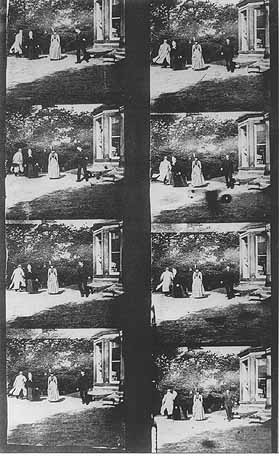 |
|---|
Marey was strongly stimulated by the demonstrations by Eadweard Muybridge in French salons of his trotting horses and walking nude models around 1878. These performances had also inspired Augustin Le Prince. Probably also the Englishman Birt Acres who studied at the art academy of Paris.
Muybridge, hoever, was not the inventor of the animated photographic images. That was his patron Leland Stanford, governor of Californië, and later founder of the Stanford University. Stanford wished to determine scientifically whether all four legs of a galloping horse got off the ground . He looked for a knowledgeable photographer to assist him in his research. Stanford was inspired by earlier experiments of Marey with his so-called Janssen-rifle, an apparatus that makes repetitive photographic exposures on a glass disc covered with a photographic emulsion.
.
In 1889 Thomas Alva Edison visited the Exposition Internationale in Paris. Every evening he telegraphed from his hotel room to his workshops his famous 'caveats' - ideas for possible patents based on all what he saw there .
Edison not only saw the work of Reynaud, but visited also professor Marey in his institute, who felt very honored. From Hendricks we learn how in Edison's workshops with ups and downs kinetoscopes were being developed by W.K.L. Dickson .
Mechanism of a kinetoscoop with shortened (probably repaired) film strip.
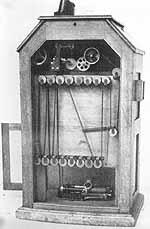 |
|---|
When one compares the patent drawings of the 'chronophotographe' and the 'kinetoscope' one discovers only one elementary difference. Whereas Marey made the basic change to short lengths of finite film strips, a breach in the tradition of the zoëtropes, in Edison's workshops an endless loop of film was reverted to. Besides that there are technically few differences (apart from the size of both of the apparatus, which is not essential in itself). Probably Antoine Lumière and Carpentier had already found this out in 1894.
Public interest in the moving image was aroused from the time kinetoscopes were introduced. The Lumière company took advantage of a growing success, a practice not unusual in business. A good example is the introduction of the personal computer by IBM. The company can hardly be called the inventor.
The first life cycle of the movie is actually one of moving photographic images: living, or animated pictures, moving photographs.
In the archives of Arthur Melbourne-Cooper, which his daughter Audrey assembled in years of research, is a tape-recorded interview with the residents of the hamlet Ridge Hill (nearby the later Elstree Studios in Borehamwood), where Cooper began his Alpha Trading Company. The interviewed, now at an advanced age, still remembered with enthusiasm the first film shows they had attended sixty years ago:
'You them m�ving. The leaves on the trees moved. You saw someone really waving his hand. It was unbelievable.'
Around 1900 Edison, Lumi�re, as well as the Englishman Robert W. Paul announced their intention to invest in the motion picture industry. They were aware of a decreased public interest. Films were now shown during intermissions, when the audience changed, as 'patron chasers'.
Some film producers did not give up and pondered about something new. Georges Méliès in France, Arthur Melbourne-Cooper in Engeland en Edwin S. Porter in Amerika are those who succeeded in combining a series of moving picture scenes to a cinematographic story.
Bertha M. Cooper and Bert Massey in Arthur Melbourne-Cooper's 'Grandma's Reading Glass' (1900), the first movie with clear purposeful editing of close-ups within a half total shot, ascribed to G.A. Smith of Brighton.
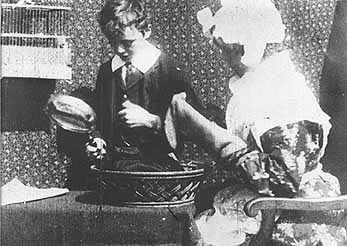 |
|---|
The origin of film language
With the short movie 'Grandma's Reading Glass' of July 1900 the history of the cinema begins. For the first time shots are being interposed with a clear purpose in between a half total scene. The birth of film editing.
This short film was attributed to George Albert Smith mistakenly by author Georges Sadoul. Actually it was produced by the aforementioned Cooper, who was so put down by British film historian Low for his 'strange and unsuccessful experiments'!
Two children play grandmother and grandson. Little grandmother comes in frame and picks up her knitting. The 'grandson' appears, takes his grandmother's reading glass and looks through it in a newspaper. At the very moment the boy studies the newspaper, a close-up of what he sees appears. A miracle happens: first being objective onlookers, now we are 'carried away' by the sequence of pictures and become, whether we like it or not, a subjective audience. We watch now through the eyes of the little boy.
This is no coincidence for the boy directs his glass to a canary in a bird cage, at grandmother's eye, and at other objects. Again and again we change from objective onlooker to a subjective view. Film language was born with this short. A language which is capable of carrying us from the confinement of the film screen to a world populated by wonderful gods and goddesses. Not long after Méliès 'Le voyage dans la lune' (1902) became a success and Porter with his "The great train robbery' (1903).
So, who invented motion pictures?
We can now draw some preliminary conclusions. In the technical evolution of motion pictures we can distinguish certain lines. However, just like the music CD emerged out of a flop by Philips of a premature launched laser-disc system, so not many of all the 'inventors' involved were out to discover cinematography.
Le Prince had the cinematographic diorama in mind. Antoine Lumière was probably keen to expand the market of his main activity: the manufacture of photographic materials. Edison wanted to create living pictures that ran in sync with his sound apparatus. Marey and Acres wanted to develop apparatus for scientific research.
George Eastman (left) and Edison in the twenties when the media credited them with the invention of motion pictures.
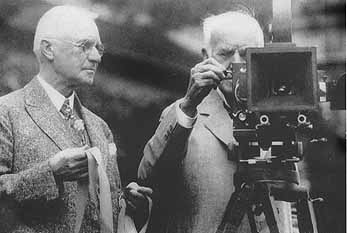 |
|---|
The question as to who invented the cinema has intrigued the public, reporters and all those concerned from the very beginning. As far back as 1896 it was a topic in 'The Amateur Photographer' (at that period of time 'amateur' meant 'professional').
Birt Acres writes on October 6th of that year: '(.....) at this branch of photography, it is really difficult to assign to any one individual the title of origination.' Acres refers to the inventor of the zoëtrope or 'wheel of life' and then names Muybridge, Friese-Greene, Anschütz, Marie (he means: Marey) and Demeny. Then he enters at length into the Edison's kinetoscope and his own work, 'without claiming to be the originator of animated photography I do claim to have been the first to have made a portable apparatus which successfully took photographs of ordinary scenes of everyday life.'
Mechanism of Birt Acres' "Kineopticon" of 1895, now displayed in the Science Museum, Londen.
He acknowledges the success of the first Lumière shows, but: 'Since their successful exhibition a host of others have come forward with similar shows, but as Lumière's would not sell their apparatus or films, imitators had depended on Edison films, or such of mine that could be obtained, I having ceased to supply mine for some time.'
Acres is right in arguing that the apparatus of Lumière in itself contributed little to the rapid development of cinematography. Antoine Lumière behaved like the Apple company. Their MacIntosh proved to be no match for the easily cloneable IBM-pc with its open architecture.
Darling Duplex camera around 1900 could be ordered from Alfred Darling in Brighton.
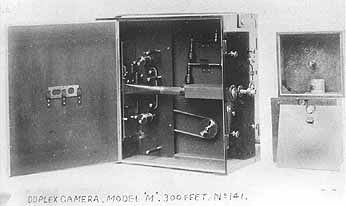 |
|---|
It was the since forgotten engineer, Alfred Darling, who studied the patent drawings of the Cinématographe Lumière and manufactured an improved model for film perforated according to the Edison norm. Like Cooper he supplied to 'the wholesale trade only'. His technically superior and reliable cameras, projectors and printers were sold the world over under trade names as Prestwich, Williamson, Moy, Wrench and Urban.
When after 1900 the film story developed, it was accompanied by an efficient publicity machinery. That meant publications and books that repeated the myth of the great inventors Edison and Lumière, instead of enquiring into the matter.
The detrimental side of such mythology is clear now. First of all the contribution of the creative film producers and inventors of the new technology is underestimated, forgotten, or even denied. The latter is the case with English pioneer Arthur Melbourne-Cooper. Although for twenty years he has been an independent, stimulating and influential director-producer, his work is now forgotten and most of his films are ascribed to the distributors he sold to.
Beach scenes taken in Dover by Acres in 1892-93 with his kinetic 70mm camera
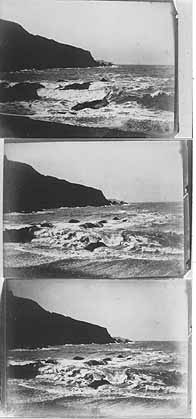 |
|---|
By the narrow perspective of those who write about film history there exists an indirect but nevertheless great danger. Movies are very much subject to trends, also because of producer controled publicity .
What is now being stored in vaults all the world over is perishable nitrate film which contains a precious view of our time and that of our parents and grandparents for coming generations. It is also an unthought-of treasure for other disciplines and branches of science: sociology, cultural anthropology, photography, fashion, art, etc.
(This article was published for the first time in the Photohistorical Magazine of the Photographic Society of the Netherlands in 1995)
© (text and photographs) Tjitte de Vries 2006
On the web as from 23rd November 2001. Revised: 19 December 2017.
---
### Links:
* Birt Acres: Film Pioneer * National Museum: Pioneers of Early Cinema: Birt Acres * Wikipedia.fr: Auguste et Louis Lumiere
---
"They Thought It Was A Marvel. Arthur Melbourne-Cooper (1874-1961) Pioneer of Puppet Animation", by Tjitte de Vries and Ati Mul. Approx. 600 pages, bound, illustr., with DVD with six animation films. Published by the Amsterdam University Press, in co-operation with the Netherlands Filmmuseum, as a Pallas Publication. ISBN 9789085550167. Price Euro 39,50.
---
Bill Acres - Film Pioneer | Collecting cinematographica | | 100 years of film sizes | | links | | List of 3000 cameras and projectors |